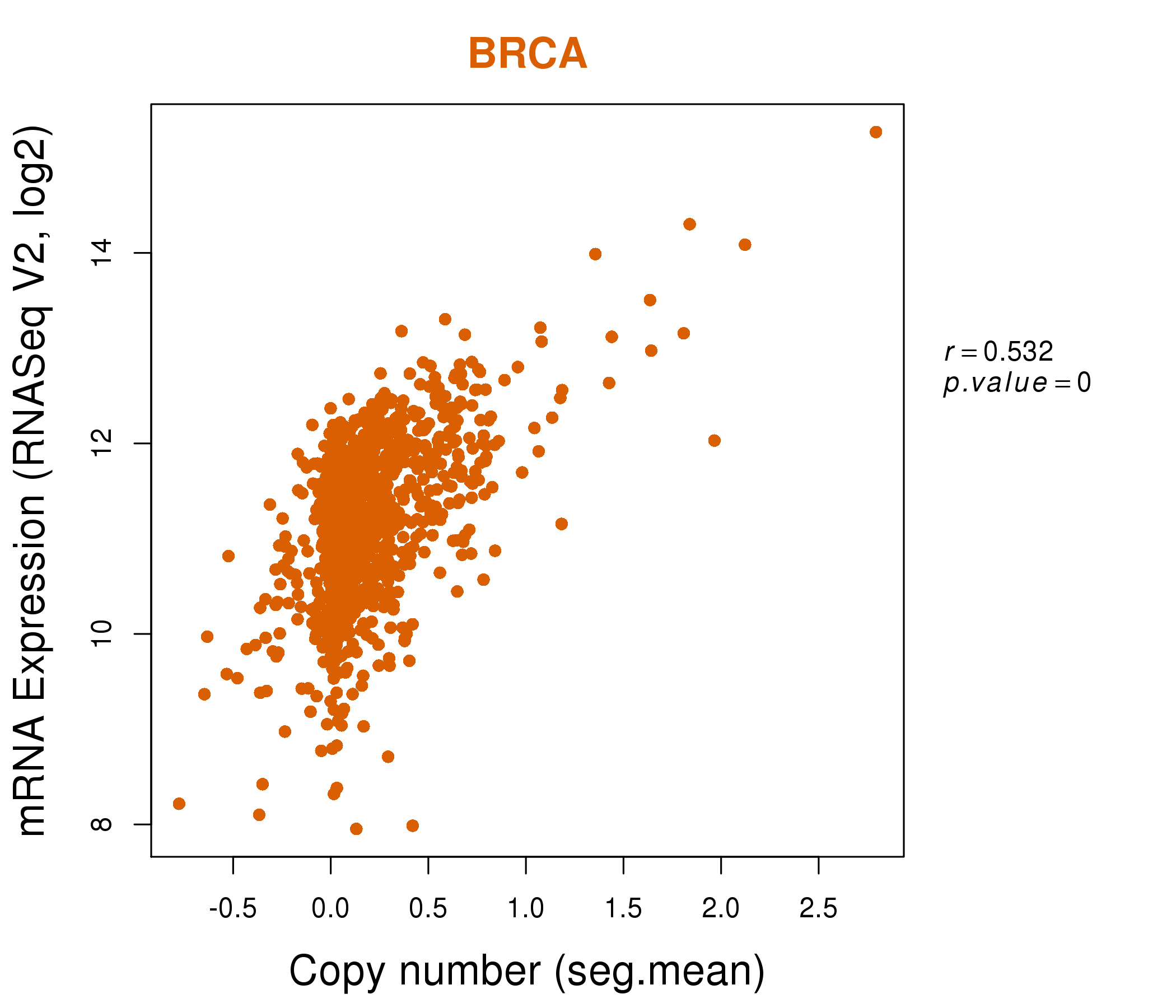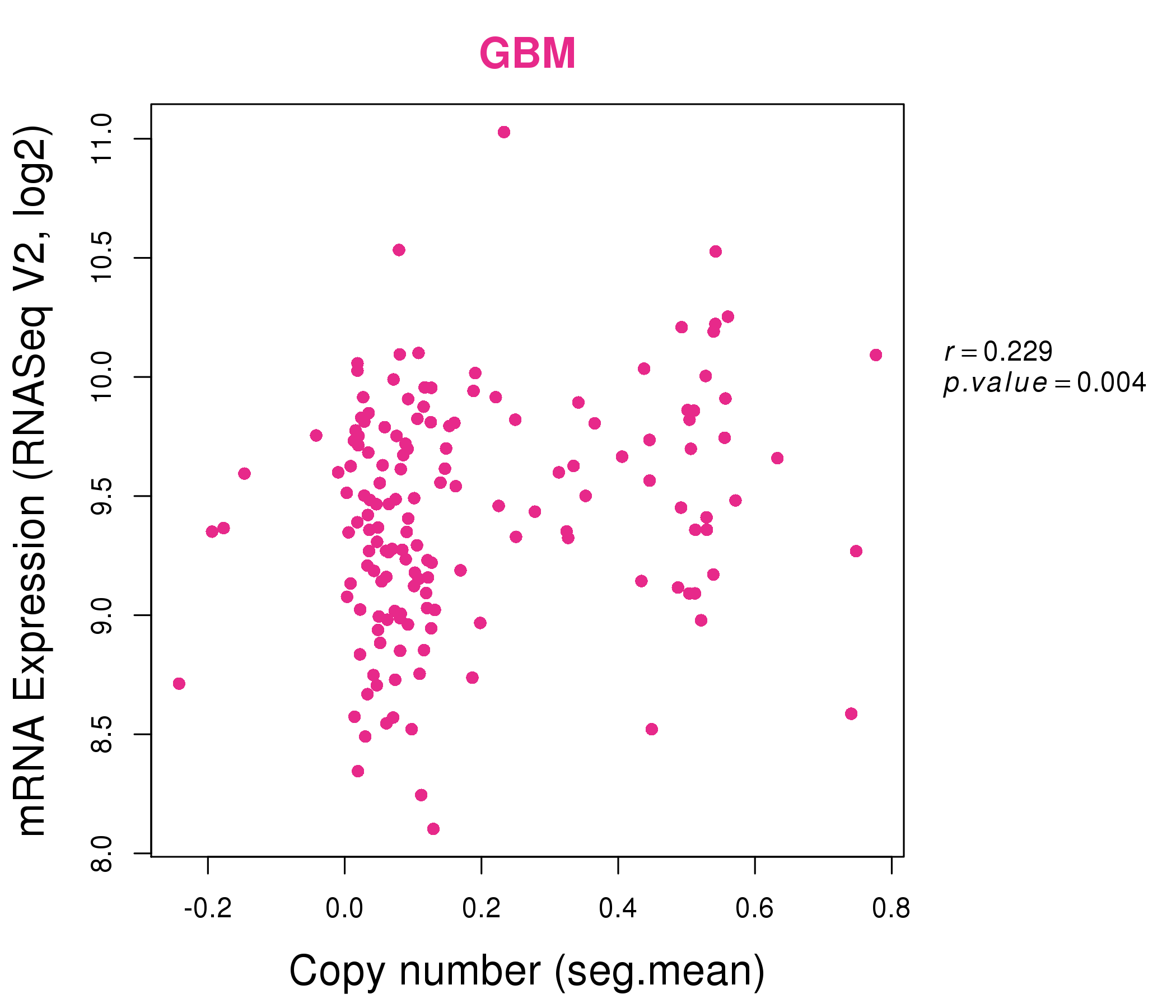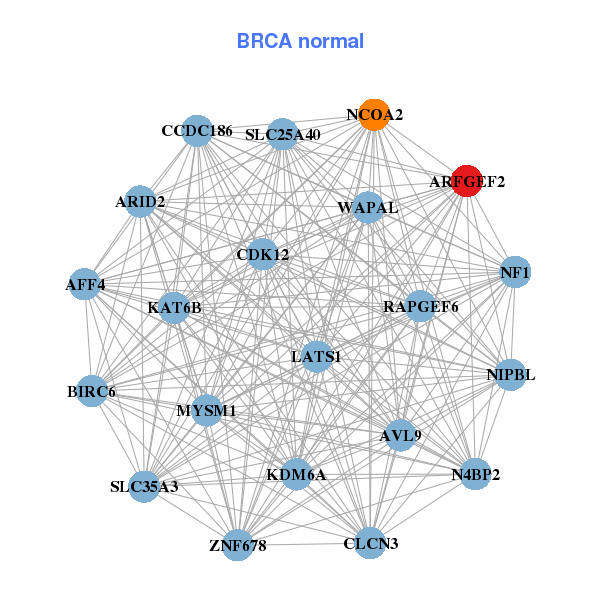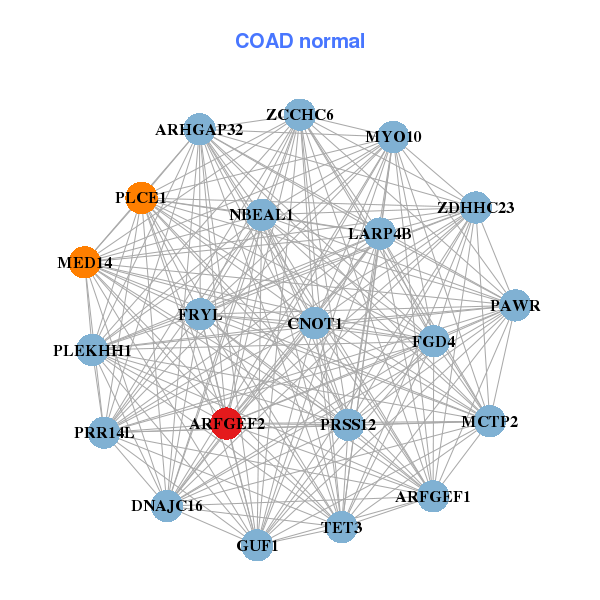|
||||||||||||||||||||||||||||||||||||||||||||||||||||||||||||||||||||||||||||||||||||||||||||||||||||||||||||||||||||||||||||||||||||||||||||||||||||||||||||||||||||||||||||||||||||||||||||||||||||||||||||||||||||||||||||||||||||||||||||||||||||||||||||||||||||||||||||||||||||||||||||||||||||||||||||||||||||||||||
| |
| Phenotypic Information (metabolism pathway, cancer, disease, phenome) |
| |
| |
| Gene-Gene Network Information: Co-Expression Network, Interacting Genes & KEGG |
| |
|
| Gene Summary for ARFGEF2 |
| Basic gene info. | Gene symbol | ARFGEF2 |
| Gene name | ADP-ribosylation factor guanine nucleotide-exchange factor 2 (brefeldin A-inhibited) | |
| Synonyms | BIG2|PVNH2|dJ1164I10.1 | |
| Cytomap | UCSC genome browser: 20q13.13 | |
| Genomic location | chr20 :47538274-47653230 | |
| Type of gene | protein-coding | |
| RefGenes | NM_006420.2, | |
| Ensembl id | ENSG00000124198 | |
| Description | brefeldin A-inhibited GEP 2brefeldin A-inhibited guanine nucleotide-exchange protein 2 | |
| Modification date | 20141207 | |
| dbXrefs | MIM : 605371 | |
| HGNC : HGNC | ||
| Ensembl : ENSG00000124198 | ||
| HPRD : 09250 | ||
| Vega : OTTHUMG00000032687 | ||
| Protein | UniProt: Q9Y6D5 go to UniProt's Cross Reference DB Table | |
| Expression | CleanEX: HS_ARFGEF2 | |
| BioGPS: 10564 | ||
| Gene Expression Atlas: ENSG00000124198 | ||
| The Human Protein Atlas: ENSG00000124198 | ||
| Pathway | NCI Pathway Interaction Database: ARFGEF2 | |
| KEGG: ARFGEF2 | ||
| REACTOME: ARFGEF2 | ||
| ConsensusPathDB | ||
| Pathway Commons: ARFGEF2 | ||
| Metabolism | MetaCyc: ARFGEF2 | |
| HUMANCyc: ARFGEF2 | ||
| Regulation | Ensembl's Regulation: ENSG00000124198 | |
| miRBase: chr20 :47,538,274-47,653,230 | ||
| TargetScan: NM_006420 | ||
| cisRED: ENSG00000124198 | ||
| Context | iHOP: ARFGEF2 | |
| cancer metabolism search in PubMed: ARFGEF2 | ||
| UCL Cancer Institute: ARFGEF2 | ||
| Assigned class in ccmGDB | B - This gene belongs to cancer gene. | |
| Top |
| Phenotypic Information for ARFGEF2(metabolism pathway, cancer, disease, phenome) |
| Cancer | CGAP: ARFGEF2 |
| Familial Cancer Database: ARFGEF2 | |
| * This gene is included in those cancer gene databases. |
|
|
|
|
|
| . | ||||||||||||||||||||||||||||||||||||||||||||||||||||||||||||||||||||||||||||||||||||||||||||||||||||||||||||||||||||||||||||||||||||||||||||||||||||||||||||||||||||||||||||||||||||||||||||||||||||||||||||||||||||||||||||||||||||||||||||||||||||||||||||||||||||||||||||||||||||||||||||||||||||||||||||||||||||
Oncogene 1 | Significant driver gene in | |||||||||||||||||||||||||||||||||||||||||||||||||||||||||||||||||||||||||||||||||||||||||||||||||||||||||||||||||||||||||||||||||||||||||||||||||||||||||||||||||||||||||||||||||||||||||||||||||||||||||||||||||||||||||||||||||||||||||||||||||||||||||||||||||||||||||||||||||||||||||||||||||||||||||||||||||||||||||
| cf) number; DB name 1 Oncogene; http://nar.oxfordjournals.org/content/35/suppl_1/D721.long, 2 Tumor Suppressor gene; https://bioinfo.uth.edu/TSGene/, 3 Cancer Gene Census; http://www.nature.com/nrc/journal/v4/n3/abs/nrc1299.html, 4 CancerGenes; http://nar.oxfordjournals.org/content/35/suppl_1/D721.long, 5 Network of Cancer Gene; http://ncg.kcl.ac.uk/index.php, 1Therapeutic Vulnerabilities in Cancer; http://cbio.mskcc.org/cancergenomics/statius/ |
| REACTOME_METABOLISM_OF_PROTEINS | |
| OMIM | 605371; gene. 608097; phenotype. |
| Orphanet | 98892; Periventricular nodular heterotopia. |
| Disease | KEGG Disease: ARFGEF2 |
| MedGen: ARFGEF2 (Human Medical Genetics with Condition) | |
| ClinVar: ARFGEF2 | |
| Phenotype | MGI: ARFGEF2 (International Mouse Phenotyping Consortium) |
| PhenomicDB: ARFGEF2 | |
| Mutations for ARFGEF2 |
| * Under tables are showing count per each tissue to give us broad intuition about tissue specific mutation patterns.You can go to the detailed page for each mutation database's web site. |
| - Statistics for Tissue and Mutation type | Top |
 |
| - For Inter-chromosomal Variations |
| * Inter-chromosomal variantions includes 'interchromosomal amplicon to amplicon', 'interchromosomal amplicon to non-amplified dna', 'interchromosomal insertion', 'Interchromosomal unknown type'. |
 |
| - For Intra-chromosomal Variations |
| * Intra-chromosomal variantions includes 'intrachromosomal amplicon to amplicon', 'intrachromosomal amplicon to non-amplified dna', 'intrachromosomal deletion', 'intrachromosomal fold-back inversion', 'intrachromosomal inversion', 'intrachromosomal tandem duplication', 'Intrachromosomal unknown type', 'intrachromosomal with inverted orientation', 'intrachromosomal with non-inverted orientation'. |
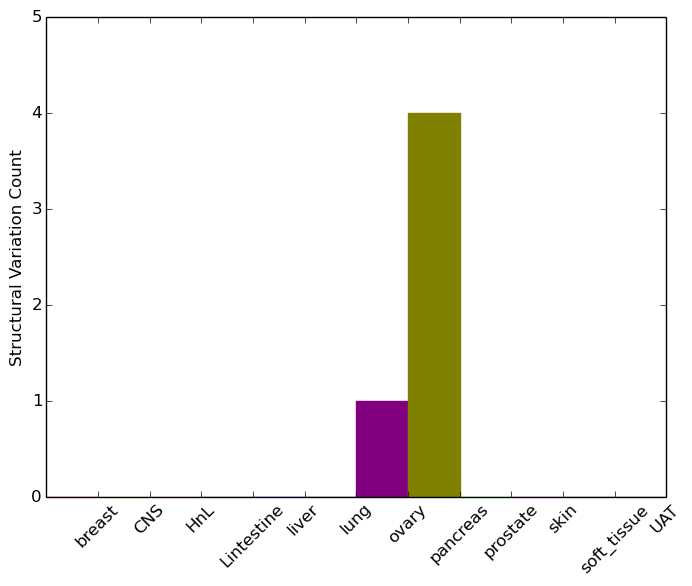 |
| Sample | Symbol_a | Chr_a | Start_a | End_a | Symbol_b | Chr_b | Start_b | End_b |
| ovary | ARFGEF2 | chr20 | 47567969 | 47567989 | BCAS3 | chr17 | 59206341 | 59206361 |
| ovary | ARFGEF2 | chr20 | 47634319 | 47634339 | ARFGEF2 | chr20 | 47601284 | 47601304 |
| pancreas | ARFGEF2 | chr20 | 47569446 | 47569466 | ARFGEF2 | chr20 | 47570023 | 47570043 |
| pancreas | ARFGEF2 | chr20 | 47588914 | 47588934 | chr20 | 48113886 | 48113906 | |
| pancreas | ARFGEF2 | chr20 | 47592066 | 47592086 | ARFGEF2 | chr20 | 47592352 | 47592372 |
| pancreas | ARFGEF2 | chr20 | 47626037 | 47626057 | ARFGEF2 | chr20 | 47626142 | 47626162 |
| cf) Tissue number; Tissue name (1;Breast, 2;Central_nervous_system, 3;Haematopoietic_and_lymphoid_tissue, 4;Large_intestine, 5;Liver, 6;Lung, 7;Ovary, 8;Pancreas, 9;Prostate, 10;Skin, 11;Soft_tissue, 12;Upper_aerodigestive_tract) |
| * From mRNA Sanger sequences, Chitars2.0 arranged chimeric transcripts. This table shows ARFGEF2 related fusion information. |
| ID | Head Gene | Tail Gene | Accession | Gene_a | qStart_a | qEnd_a | Chromosome_a | tStart_a | tEnd_a | Gene_a | qStart_a | qEnd_a | Chromosome_a | tStart_a | tEnd_a |
| AW752522 | ARFGEF2 | 13 | 203 | 20 | 47587657 | 47587847 | TMED11P | 189 | 491 | 4 | 1110360 | 1110662 | |
| Top |
| Mutation type/ Tissue ID | brca | cns | cerv | endome | haematopo | kidn | Lintest | liver | lung | ns | ovary | pancre | prost | skin | stoma | thyro | urina | |||
| Total # sample | 6 | 1 | 1 | |||||||||||||||||
| GAIN (# sample) | 6 | 1 | 1 | |||||||||||||||||
| LOSS (# sample) |
| cf) Tissue ID; Tissue type (1; Breast, 2; Central_nervous_system, 3; Cervix, 4; Endometrium, 5; Haematopoietic_and_lymphoid_tissue, 6; Kidney, 7; Large_intestine, 8; Liver, 9; Lung, 10; NS, 11; Ovary, 12; Pancreas, 13; Prostate, 14; Skin, 15; Stomach, 16; Thyroid, 17; Urinary_tract) |
| Top |
|
 |
| Top |
| Stat. for Non-Synonymous SNVs (# total SNVs=145) | (# total SNVs=35) |
 | 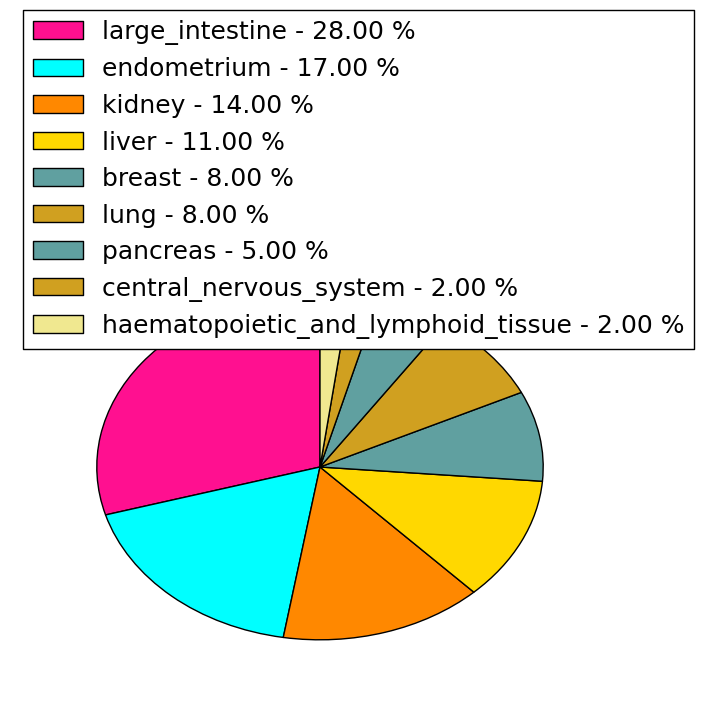 |
(# total SNVs=1) | (# total SNVs=0) |
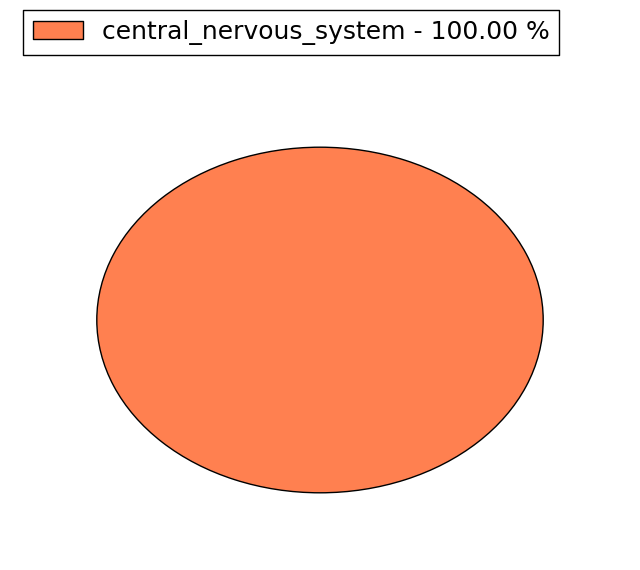 |
| Top |
| * When you move the cursor on each content, you can see more deailed mutation information on the Tooltip. Those are primary_site,primary_histology,mutation(aa),pubmedID. |
| GRCh37 position | Mutation(aa) | Unique sampleID count |
| chr20:47605048-47605048 | p.K794K | 4 |
| chr20:47587670-47587670 | p.R402C | 4 |
| chr20:47585760-47585760 | p.R379H | 3 |
| chr20:47605046-47605046 | p.K794E | 3 |
| chr20:47570183-47570183 | p.R232C | 3 |
| chr20:47570297-47570297 | p.A270T | 3 |
| chr20:47588912-47588912 | p.S492Y | 3 |
| chr20:47626806-47626806 | p.A1208S | 2 |
| chr20:47645144-47645144 | p.R1668* | 2 |
| chr20:47632850-47632850 | p.A1405T | 2 |
| Top |
|
 |
| Point Mutation/ Tissue ID | 1 | 2 | 3 | 4 | 5 | 6 | 7 | 8 | 9 | 10 | 11 | 12 | 13 | 14 | 15 | 16 | 17 | 18 | 19 | 20 |
| # sample | 4 | 6 | 4 | 22 | 3 | 7 | 5 | 3 | 1 | 13 | 5 | 1 | 24 | 20 | 3 | 17 | ||||
| # mutation | 4 | 6 | 5 | 21 | 4 | 7 | 5 | 3 | 1 | 13 | 6 | 1 | 26 | 25 | 3 | 29 | ||||
| nonsynonymous SNV | 4 | 5 | 4 | 17 | 3 | 4 | 3 | 2 | 9 | 5 | 1 | 18 | 21 | 3 | 23 | |||||
| synonymous SNV | 1 | 1 | 4 | 1 | 3 | 2 | 1 | 1 | 4 | 1 | 8 | 4 | 6 |
| cf) Tissue ID; Tissue type (1; BLCA[Bladder Urothelial Carcinoma], 2; BRCA[Breast invasive carcinoma], 3; CESC[Cervical squamous cell carcinoma and endocervical adenocarcinoma], 4; COAD[Colon adenocarcinoma], 5; GBM[Glioblastoma multiforme], 6; Glioma Low Grade, 7; HNSC[Head and Neck squamous cell carcinoma], 8; KICH[Kidney Chromophobe], 9; KIRC[Kidney renal clear cell carcinoma], 10; KIRP[Kidney renal papillary cell carcinoma], 11; LAML[Acute Myeloid Leukemia], 12; LUAD[Lung adenocarcinoma], 13; LUSC[Lung squamous cell carcinoma], 14; OV[Ovarian serous cystadenocarcinoma ], 15; PAAD[Pancreatic adenocarcinoma], 16; PRAD[Prostate adenocarcinoma], 17; SKCM[Skin Cutaneous Melanoma], 18:STAD[Stomach adenocarcinoma], 19:THCA[Thyroid carcinoma], 20:UCEC[Uterine Corpus Endometrial Carcinoma]) |
| Top |
| * We represented just top 10 SNVs. When you move the cursor on each content, you can see more deailed mutation information on the Tooltip. Those are primary_site, primary_histology, mutation(aa), pubmedID. |
| Genomic Position | Mutation(aa) | Unique sampleID count |
| chr20:47605048 | p.K794K | 4 |
| chr20:47570183 | p.A270T | 2 |
| chr20:47588912 | p.L1559F | 2 |
| chr20:47621682 | p.E1170K | 2 |
| chr20:47570297 | p.S492Y | 2 |
| chr20:47639640 | p.R232C | 2 |
| chr20:47587733 | p.D1083N | 1 |
| chr20:47604875 | p.N1224N | 1 |
| chr20:47614755 | p.R423G | 1 |
| chr20:47630428 | p.W1370C | 1 |
| * Copy number data were extracted from TCGA using R package TCGA-Assembler. The URLs of all public data files on TCGA DCC data server were gathered on Jan-05-2015. Function ProcessCNAData in TCGA-Assembler package was used to obtain gene-level copy number value which is calculated as the average copy number of the genomic region of a gene. |
 |
| cf) Tissue ID[Tissue type]: BLCA[Bladder Urothelial Carcinoma], BRCA[Breast invasive carcinoma], CESC[Cervical squamous cell carcinoma and endocervical adenocarcinoma], COAD[Colon adenocarcinoma], GBM[Glioblastoma multiforme], Glioma Low Grade, HNSC[Head and Neck squamous cell carcinoma], KICH[Kidney Chromophobe], KIRC[Kidney renal clear cell carcinoma], KIRP[Kidney renal papillary cell carcinoma], LAML[Acute Myeloid Leukemia], LUAD[Lung adenocarcinoma], LUSC[Lung squamous cell carcinoma], OV[Ovarian serous cystadenocarcinoma ], PAAD[Pancreatic adenocarcinoma], PRAD[Prostate adenocarcinoma], SKCM[Skin Cutaneous Melanoma], STAD[Stomach adenocarcinoma], THCA[Thyroid carcinoma], UCEC[Uterine Corpus Endometrial Carcinoma] |
| Top |
| Gene Expression for ARFGEF2 |
| * CCLE gene expression data were extracted from CCLE_Expression_Entrez_2012-10-18.res: Gene-centric RMA-normalized mRNA expression data. |
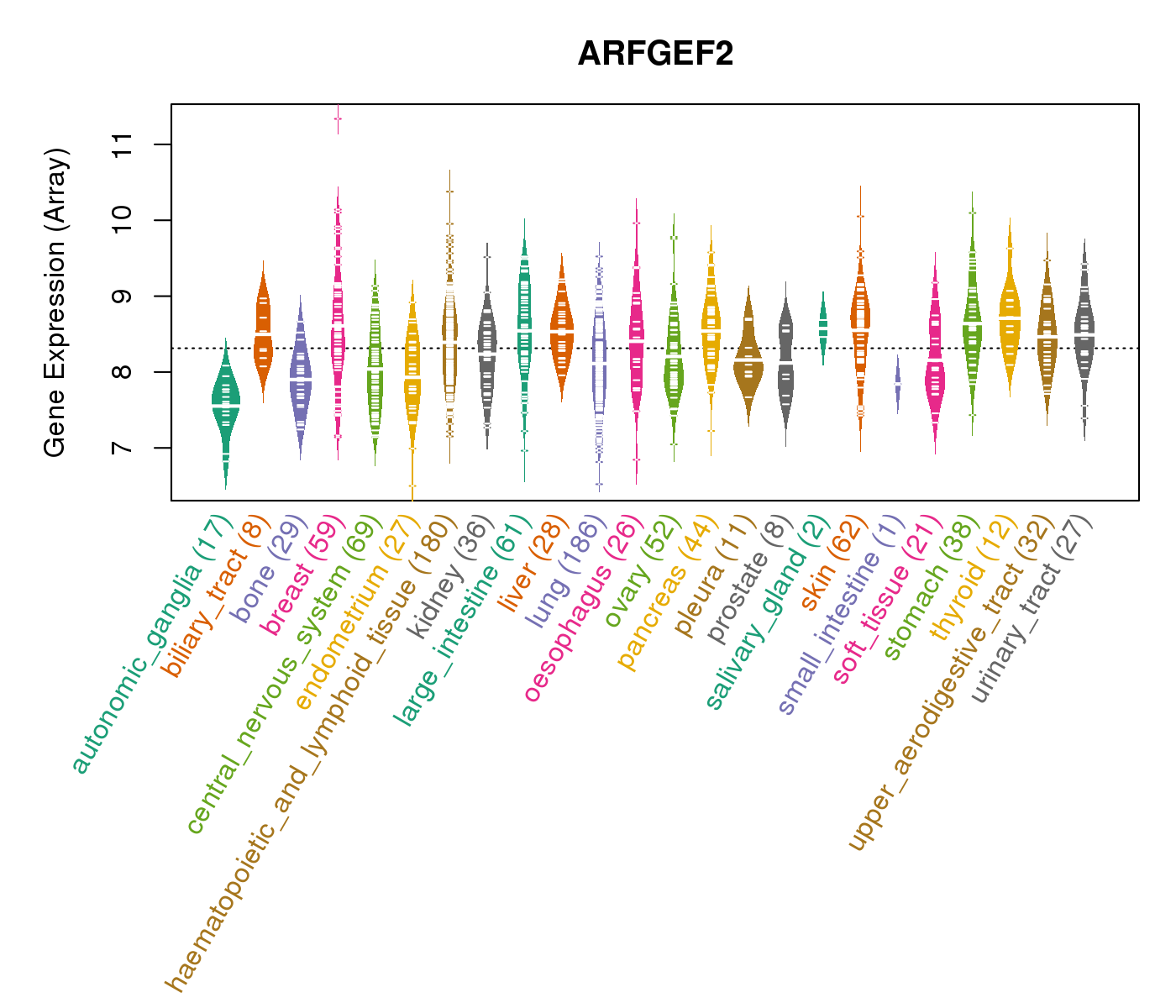 |
| * Normalized gene expression data of RNASeqV2 was extracted from TCGA using R package TCGA-Assembler. The URLs of all public data files on TCGA DCC data server were gathered at Jan-05-2015. Only eight cancer types have enough normal control samples for differential expression analysis. (t test, adjusted p<0.05 (using Benjamini-Hochberg FDR)) |
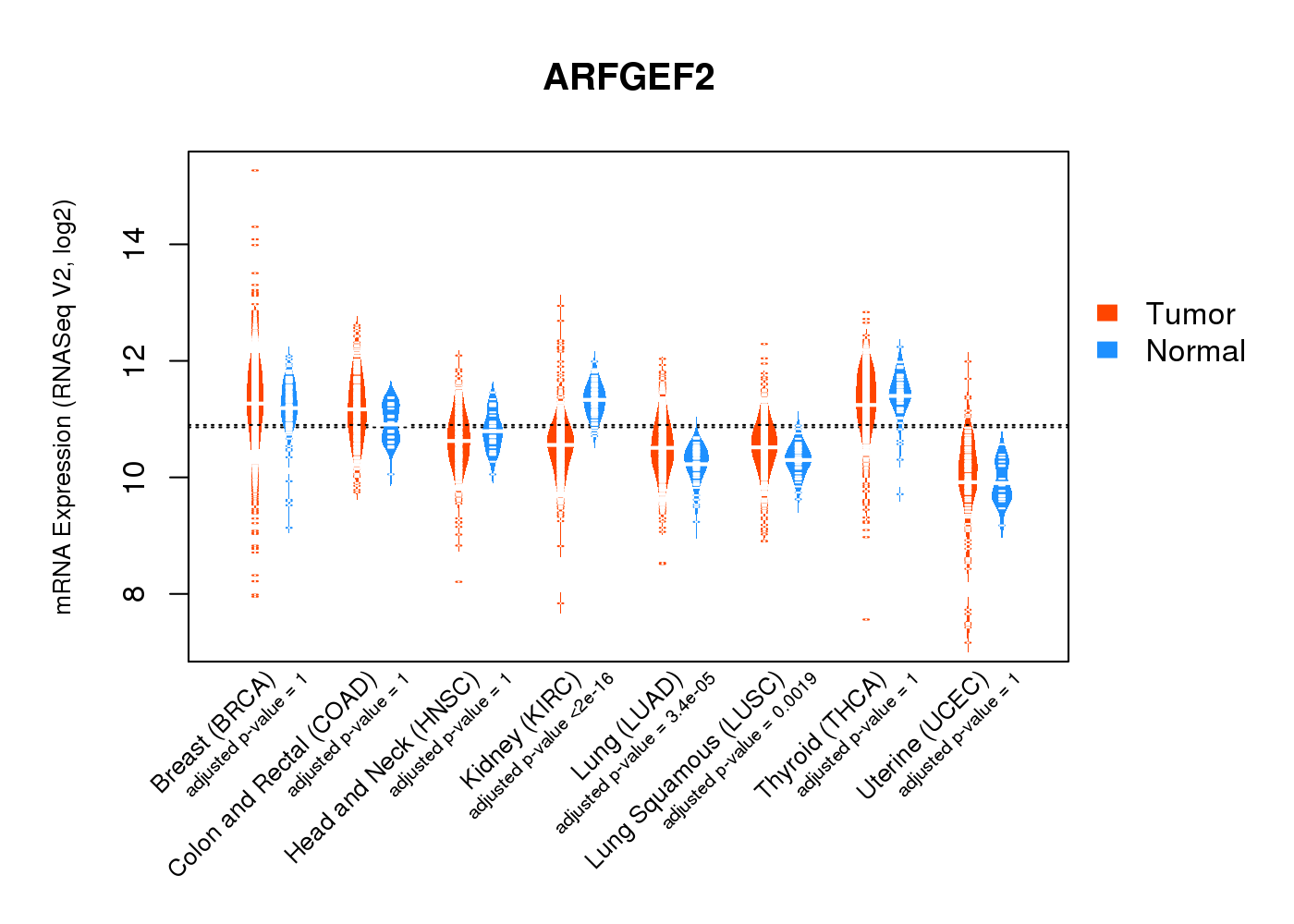 |
| Top |
| * This plots show the correlation between CNV and gene expression. |
: Open all plots for all cancer types
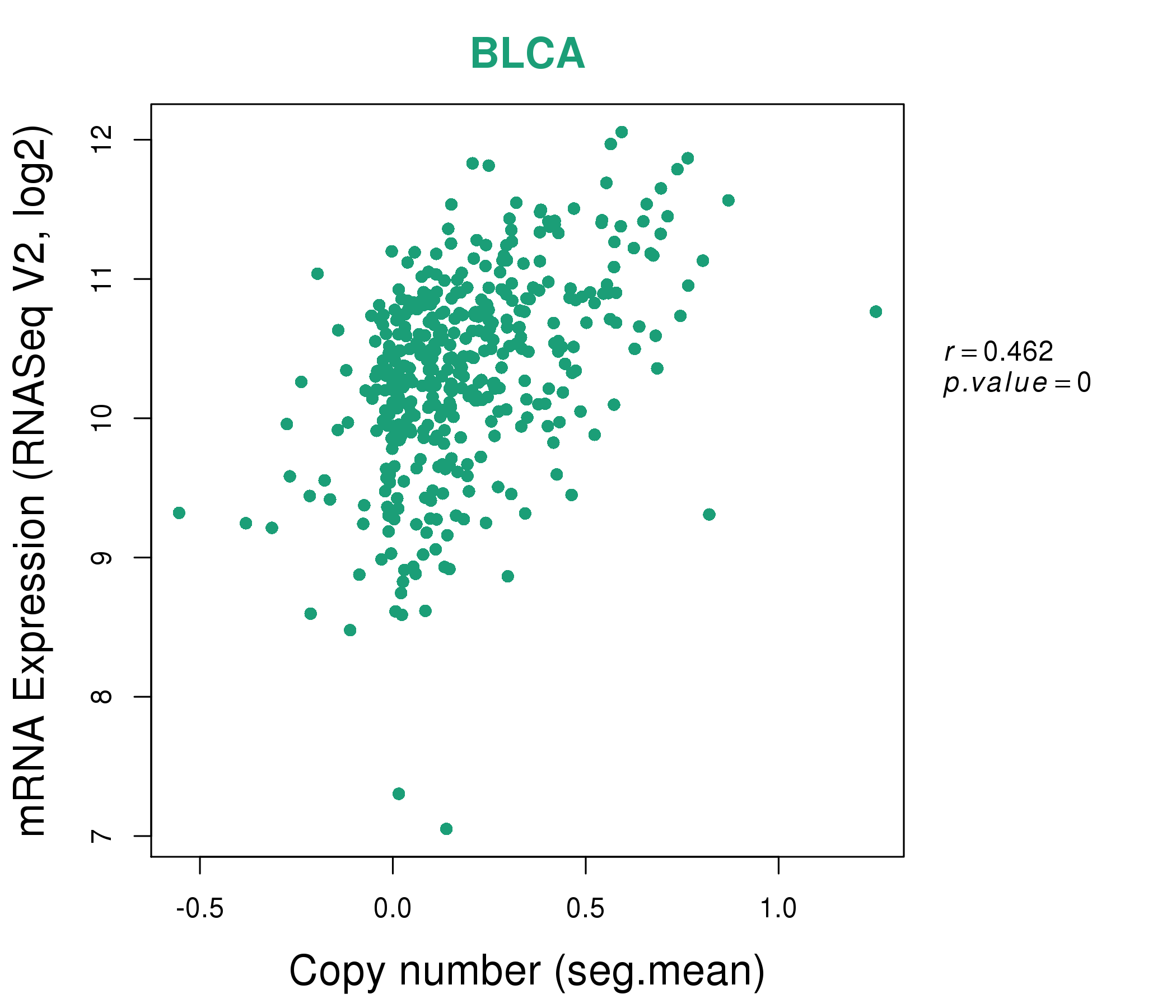 |
|
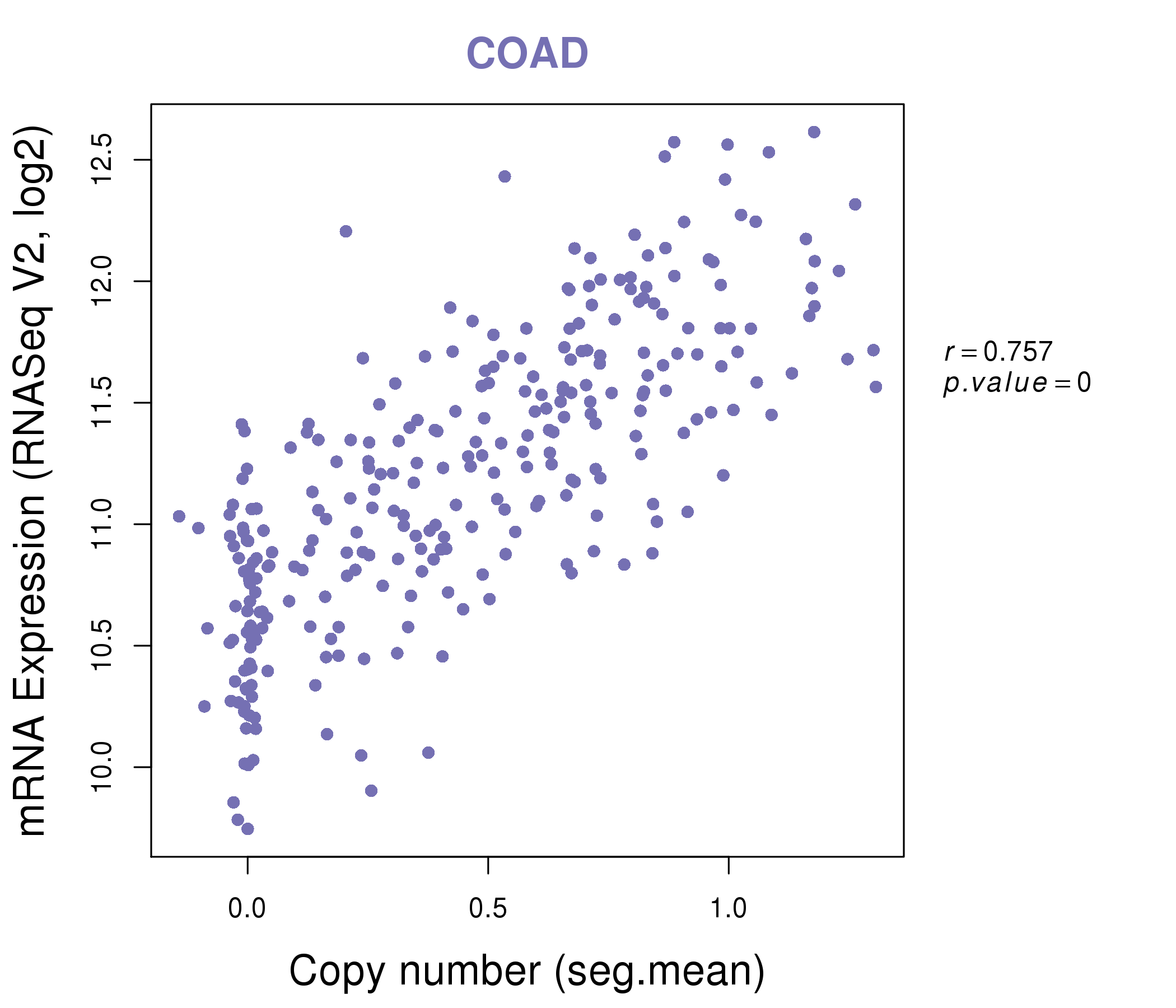 |
|
| Top |
| Gene-Gene Network Information |
| * Co-Expression network figures were drawn using R package igraph. Only the top 20 genes with the highest correlations were shown. Red circle: input gene, orange circle: cell metabolism gene, sky circle: other gene |
: Open all plots for all cancer types
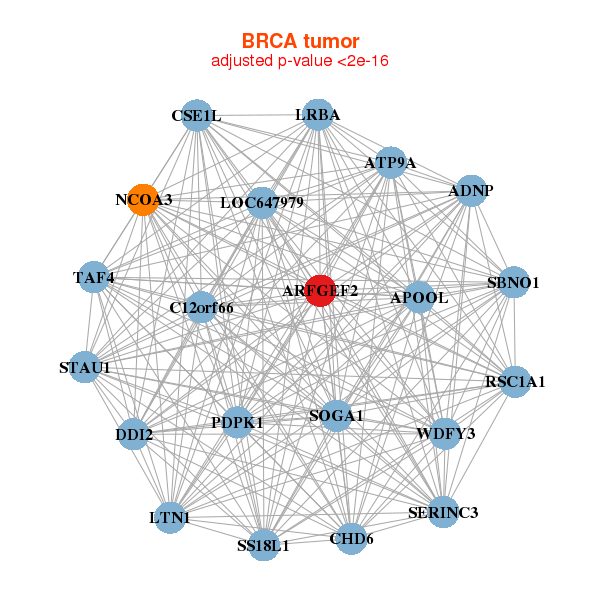 |
|
| ADNP,APOOL,ARFGEF2,ATP9A,C12orf66,SOGA1,CHD6, CSE1L,DDI2,LOC647979,LRBA,NCOA3,PDPK1,LTN1, RSC1A1,SBNO1,SERINC3,SS18L1,STAU1,TAF4,WDFY3 | AFF4,ARFGEF2,ARID2,AVL9,BIRC6,CCDC186,CDK12, CLCN3,KDM6A,LATS1,MYSM1,KAT6B,N4BP2,NCOA2, NF1,NIPBL,RAPGEF6,SLC25A40,SLC35A3,WAPAL,ZNF678 |
 |
|
| ADNP,ARFGEF2,ASXL1,ATP9A,NOL4L,FAM217B,DIDO1, ITCH,KIF3B,LOC647979,NCOA3,NCOA6,PHF20,PLAGL2, POFUT1,PPP1R3D,PXMP4,RALGAPB,RPRD1B,STAU1,TAF4 | ARFGEF1,ARFGEF2,ARHGAP32,PRR14L,CNOT1,DNAJC16,FGD4, FRYL,GUF1,LARP4B,MCTP2,MED14,MYO10,NBEAL1, PAWR,PLCE1,PLEKHH1,PRSS12,TET3,ZCCHC6,ZDHHC23 |
| * Co-Expression network figures were drawn using R package igraph. Only the top 20 genes with the highest correlations were shown. Red circle: input gene, orange circle: cell metabolism gene, sky circle: other gene |
: Open all plots for all cancer types
| Top |
: Open all interacting genes' information including KEGG pathway for all interacting genes from DAVID
| Top |
| Pharmacological Information for ARFGEF2 |
| There's no related Drug. |
| Top |
| Cross referenced IDs for ARFGEF2 |
| * We obtained these cross-references from Uniprot database. It covers 150 different DBs, 18 categories. http://www.uniprot.org/help/cross_references_section |
: Open all cross reference information
|
Copyright © 2016-Present - The Univsersity of Texas Health Science Center at Houston @ |






